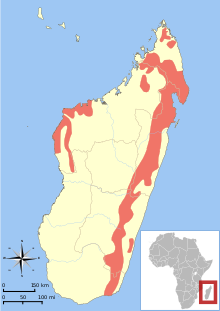| Aye-aye | |
|---|---|

| |
| Scientific classification | |
| Domain: | Eukaryota |
| Kingdom: | Animalia |
| Phylum: | Chordata |
| Class: | Mammalia |
| Order: | Primates |
| Suborder: | Strepsirrhini |
| Family: | Daubentoniidae |
| Genus: | Daubentonia |
| Species: | D. madagascariensis
|
| Binomial name | |
| Daubentonia madagascariensis (Gmelin, 1788)
| |

| |
| D. madagascariensis distribution[1] | |
| Synonyms | |
|
Species:
| |
The aye-aye (Daubentonia madagascariensis) is a long-fingered lemur, a strepsirrhine primate native to Madagascar with rodent-like teeth that perpetually grow[3] and a special thin middle finger that they can use to catch grubs and larvae out of tree trunks.
It is the world's largest nocturnal primate.[4] It is characterized by its unusual method of finding food: it taps on trees to find grubs, then gnaws holes in the wood using its forward-slanting incisors to create a small hole into which it inserts its narrow middle finger to pull the grubs out. This foraging method is called percussive foraging, and takes up 5–41% of foraging time.[5][6] The only other living mammal species known to find food in this way are the striped possum and trioks (genus Dactylopsila) of northern Australia and New Guinea, which are marsupials.[7] From an ecological point of view, the aye-aye fills the niche of a woodpecker, as it is capable of penetrating wood to extract the invertebrates within.[8][9]
The aye-aye is the only extant member of the genus Daubentonia and family Daubentoniidae. It is currently classified as Endangered by the IUCN. A second species, Daubentonia robusta, appears to have become extinct at some point within the last 1000 years, and is known from subfossil finds.[10]
- ^ a b Cite error: The named reference
IUCNwas invoked but never defined (see the help page). - ^ Cite error: The named reference
CITESwas invoked but never defined (see the help page). - ^ Petter, J.; Albignac, R.; Rumpler, Y. (1977). "Primates Prosimiens". ORSTOM.
- ^ Cite error: The named reference
nationalgeographicwas invoked but never defined (see the help page). - ^ Erickson, C.J.; Nowicki, S.; Dollar, L.; Goehring, N. (1998). "Percussive Foraging: Stimuli for Prey Location by Aye-Ayes (Daubentonia madagascariensis)". International Journal of Primatology. 19 (1): 111. doi:10.1023/A:1020363128240. S2CID 27737088.
- ^ Sterling, E.J.; McCreless, E.E. (2006). "Adaptations in the ayeaye: A review". Lemurs: Ecology and Adaptations. Gould L, Sauther ML.
- ^ Sterling 2003, p. 1348.
- ^ Piper 2007, p. [page needed].
- ^ Beck 2009.
- ^ Nowak 1999, pp. 533–534.
